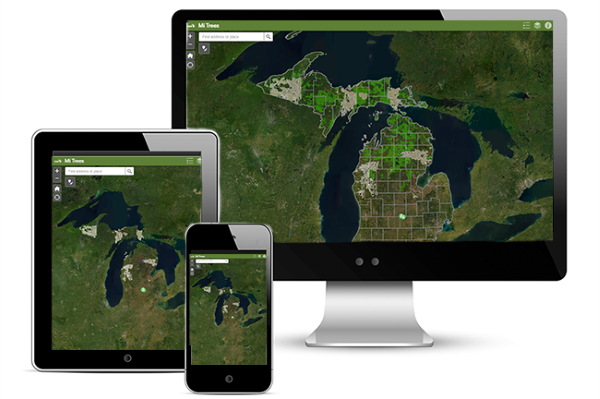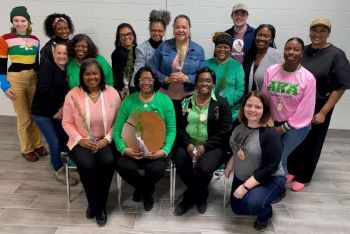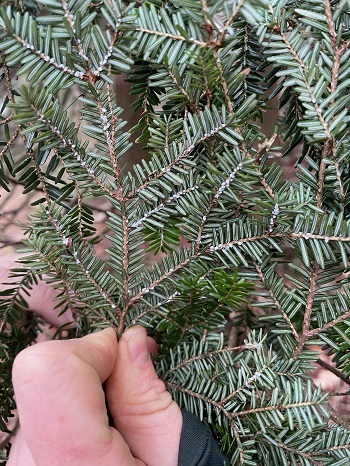|
In the forest, in your community or even in a pot on an apartment balcony – trees are important, and Arbor Day, April 28, is the day to get excited about them! We're so serious about trees, there's an official Arbor Week proclamation.
In this tree-themed newsletter, you'll find ways to get involved in a statewide tree planting initiative, be inspired by a sorority's environmental work, read fun facts about native trees and learn what to do if you spot invasive bugs.
For local Arbor Day fun, check out the Arbor Day events on our webpage.
Stories include:
 Want to join thousands of other Michiganders in a good cause? Plant a tree this spring!
The Michigan Department of Natural Resources is encouraging Michiganders to plant 50 million trees by 2030 and pin their trees’ locations on our interactive map. People have planted more than 84,000 trees already toward the goal.
The Mi Trees planting campaign is part of 1T.org, a global effort to plant more trees to help communities adapt to the world’s changing climate.
Plant your new tree with plenty of room for its roots and water it throughout the summer. Here are some more tips:
- These tips from the Arbor Day Foundation can help you choose the right tree. Staff at your local nursery can also advise you. This planting guide can help you give your tree a good start.
- Consider planting native trees, which provide food and cover for wildlife.
- Water your tree daily in the first week, then about once a week afterward. Check out the Tree Owner's Manual for more care tips.
- Visit our interactive map and log your tree.
The DNR’s Forest Resources Division sustainably manages nearly 4 million acres of state forest land, including planting millions of trees each year.

Alpha Kappa Alpha Sorority, Inc. members have been busy this month working on community-focused projects that support their “Enhance Our Environment” initiative. Three Michigan chapters around the state are collaborating with educational and government organizations. Among these collaborators is Project Learning Tree, a pre-K-12 environmental education program sponsored by the DNR. Together, they are galvanizing sorority members to make positive impacts on the environment while creating an inspiring ripple effect in their communities.
Earlier this month, Project Learning Tree educators joined two Michigan chapters, Alpha Rho Omega of Detroit and Eta Iota Omega of Inkster, for a "mini training." Sorority sisters were guided through tree planting techniques and given instructions and resources to teach engaging nature activities for local grade schools.
|

Attendee Angel Squalls, an Alpha Kappa Alpha Sorority, Inc. committee member, said, “I am a firm believer that the first step to enhancing our environment is through education and outreach, as you can't enhance what you are unaware needs improvement. We look forward to taking back what we learned and implementing it among our community and upcoming tree plantings. Accolades to our Michigan Project Learning Tree coordinator Andrea Stay and Project W.I.L.D. facilitator Natalie Elkins for putting on a great educational workshop and Huron Pines AmeriCorps members for their assistance.”
Lansing chapter Delta Tau Omega collaborated with the City of Lansing and a fourth grade class at Pattengill Biotechnical Magnet School to celebrate Earth Day on April 22. Together, they planted an American linden to beautify the schoolyard.
Alpha Kappa Alpha Sorority, Inc. was founded in 1908. It is the oldest Greek-letter organization established by African American college-educated women. Its mission focuses on encouraging high scholastic and ethical standards, promoting unity and friendship between women, alleviating problems concerning girls and women, maintaining a progressive interest in college life and to be of “Service to All Mankind.” Michigan is home to 31 chapters.
|

Did you know? White oak trees have water-resistant properties that make them great for building boats and wine barrels. Redbud trees have tiny pink flowers that bloom before the trees even grow leaves. The mighty eastern white pine, Michigan's state tree, can grow over 100 feet tall! Intrigued? Discover more facts about Michigan's trees on our native tree webpage.
|
 Whether you’re out on a trail in the woods, driving on a state forest road or in your own urban backyard, you can help keep Michigan’s trees healthy by using your powers of observation.
A sharp-eyed landowner in Oakland County spotted the first known infestation of spotted lanternfly last year. The invasive pest feeds on a variety of trees, hops and grapevines.

Michiganders also should be alert for signs and symptoms of the Asian longhorned beetle and hemlock wooly adelgid. The Asian longhorned beetle is an invader that kills hardwood trees, leaving telltale pencil-shaped holes. It has been found in nearby states. On the west side of the Lower Peninsula, folks need to be on the lookout for tiny cottony spots at the base of hemlock needles, a sign of the tiny, sap-sucking hemlock woolly adelgid insect.
If you see an oak tree with wilting, mottled green-and-brown leaves or leaves rapidly dropping before fall, starting near the top of the tree, it could be a sign of oak wilt. Beech trees are under duress from two diseases – beech bark disease and beech leaf disease.
Check out the Michigan Invasive Species Watch List to learn more about insects, animals and diseases to watch for.
There are a variety of ways to report what you see to help keep pests and diseases in check. Report sightings to the Michigan Invasive Species Information Network through its website or mobile app. You can also email the Michigan Department of Agriculture and Rural Development or DNR Forest Health team with suspected sightings of invasive species. Include photos if possible, and if you can, catch a bug and place it in the freezer to help with identification.
View and report oak wilt locations using our interactive oak wilt map. View and report Heterobasidion root disease locations using our interactive HRD map.
With the help of sharp eyes in the field like yours, forest health experts will be able to respond quickly to potential new threats to Michigan's forests.
|
|